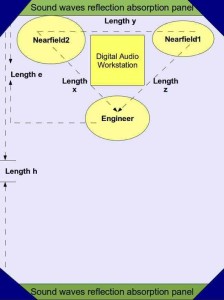Since audio mixing engineers depends on the reproduced sound to make accurate judgment about the quality of the mix; erroneously reproduced sound (due to poor room acoustics) can produce an erroneous mix.
3.) Another issue would be the placement of subwoofer. Since it is usually placed near the room corners (because this will magnify the bass levels and it feels good to them), this will horribly distort the actual or real bass level of the mix. So a mix that is lacking too much bass would sound OK in this setup.
The Solution
Take a look at the diagram below:
Some very important things you need to know:
a. length x = length y = length z , so it means that x , y and z formed an equilateral triangle.
The purpose why this should be an equilateral triangle is for optimal stereo listening or imaging. Of course, you should point the monitors to you in such a way that it forms a triangle like what is shown in the above screenshot.
b. The optimal length e can be calculated as: 38% x length h. length e is the distance from the engineer to the wall facing him. The reason for the 38% is discussed here thoroughly.
c. The blue colors on the corners are called “bass traps”. The overall purpose is to absorb low frequencies and to prevent reflections which will distort the “real” bass sound level.
d. The green are the sound waves reflection absorption panel, Their main job is to absorb mid range to high frequencies.
The only material that you will need is fiber glass. You can buy this most hardware stores in your location. Go for a thicker one that is 2 inches thick as they will absorb much reflections than the thinner fiber glass. Fiber glass is very versatile material in room studio acoustics. It is because of its ability to absorb a wider range of frequencies (from bass to high frequencies).
For this reason, you can use them as absorption panel or a bass trap. Allow some 1 inch to 2inches “minimum” space between the fiber glass and your wall to have some air between the fiber glass and the wall that would also add some benefit in your room acoustics.
If this room design will be implemented, what will happen is that the undesirable standing waves or reflected waves will be drastically minimized. Thus the only sound in the room should be coming “exactly” from the monitors and does not include the reflected waves.
For placing subwoofers, you might refer to this following tutorial:
a.)http://www.soundonsound.com/sos/feb05/articles/studiosos.htm
So in summary you need:
1.) A nearfield monitors that are properly placed in the room. (x=y=z).
2.) You will need to buy materials that will absorb sound. This will be fiber glass that you will use as absorption panel or for creating bass traps.
3.) Rearrange your room in such a way it reflects the recommended studio acoustic treatment as shown above.
Finally, you need to do some testing of your room acoustic response. This will ensure that you have radically improved the accuracy of your monitoring environment. Of course, it is also recommended that you will do this test before improving your room response. You will use this reference/original room response data in assessing the improvement of your setup.
Content last updated on July 21, 2012
